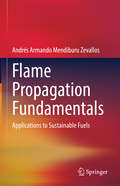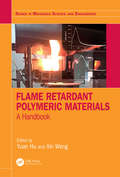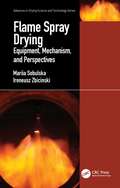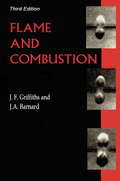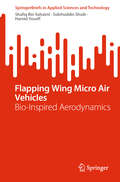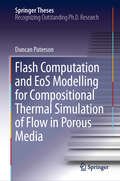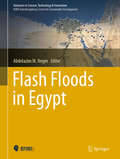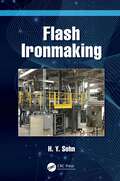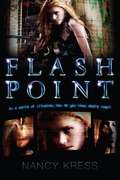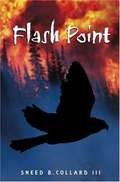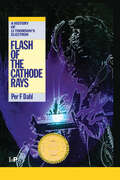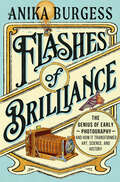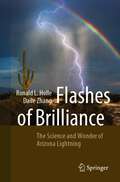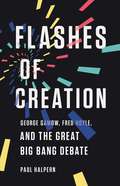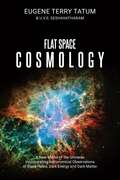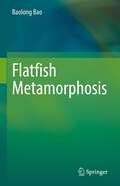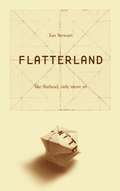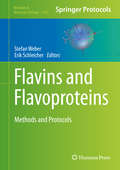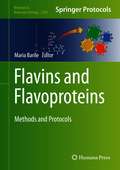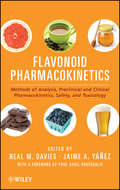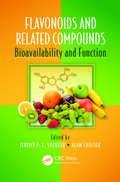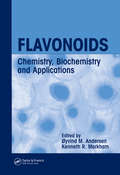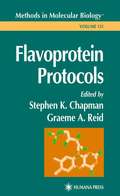- Table View
- List View
Flame Propagation Fundamentals: Applications to Sustainable Fuels
by Andrés Armando Mendiburu ZevallosThis book presents the basics of flame propagation, emphasizing the combustion of ethanol, hydrogen, and ammonia, which are fuels that could make combustion sustainable. Its eight chapters cover fundamentals such as thermodynamics of combustion, chemical kinetics, conservation equations, premixed flames, flame dynamics, compressible flow, detonations, and flammability limits. The book emphasizes important theoretical developments of flame propagation fundamentals and the significance of biofuels and alternative fuels with practical examples using ethanol, hydrogen, or ammonia, making the content directly applicable to real-world scenarios. Advanced undergraduate and graduate students, researchers, and practicing engineers in combustion, sustainable energy, transport phenomena, thermodynamics, and related fields will welcome this fundamental and practical textbook.
Flame Retardant Polymeric Materials: A Handbook (Series in Materials Science and Engineering)
by Yuan Hu and Xin WangFlame Retardant Polymeric Materials provides a comprehensive and up-to-date overview of the field, from basic properties and mechanisms of action for flame retardants to emerging methods, materials, and industrial applications. With over 120 black and white images, Hu and Wang cover the latest in the development of novel polymer nanocomposites such as graphene, CNTs, LDHs, POSS, and techniques such as layer-by-layer assembly. These expert authors also include discussions on the important flame-retardant systems based on phosphorus, silicon, and boron. In doing so, they highlight the use of flame-retardants in varying industries, for example, construction, textiles, and aviation. This comprehensive handbook is an essential read for students and academics of physics with a particular interest in flame-retardant materials. It would also be recommended for professionals within the materials science and engineering fields.
Flame Spray Drying: Equipment, Mechanism, and Perspectives (Advances in Drying Science and Technology)
by Mariia Sobulska Ireneusz ZbicinskiDrying processes are among the most energy-consuming operations in industry. Flame spray drying (FSD) is a novel approach to reduce the energy supply needed for the spray drying process. Flame Spray Drying: Equipment, Mechanism, and Perspectives describes FSD technology and current developments in flame techniques and evaluates potential industrial implementation. Details advantages of FSD in terms of energy consumption and reduced drying time Promotes applications of biofuels for the drying process Analyzes the FSD method from CFD modelling to product quality Evaluates potential safety and product degradation risks Provides examples of potential applications of the FSD technique in drying of different materials This book describes an important new technique that is useful to chemical and process engineering researchers, professionals, and students working with drying technologies.
Flame and Combustion
by J. F. GriffithsAn introduction for postgraduate and undergraduate students to the chemical and physical principles of flame and combustion phenomena. This book should be of interest to undergraduate/postgraduate chemists; chemical engineers; undergraduate/postgraduate mechanical engineers and environmental scientists; and industrial combustion technologists.
Flaming Souls: Homosexuality, Homophobia, and Social Change in Barbados
by David A.B. MurrayWhile there has been increased attention to issues of sexuality in the Caribbean over the past decade, there continue to be very few in-depth ethnographic studies of sexual minorities in this region. A timely addition to the literature, Flaming Souls explores public discourses focusing on homosexuality and the everyday lives of gay men and 'queens'in contemporary Barbados.David A.B. Murray's dynamic study features interviews with government and health agency officials, HIV/AIDS activists, and residents of the country's capital, Bridgetown. Using these and records from local libraries and archives, Murray unravels the complex historical, social, political, and economic forces through which same-sex desire, identity, and prejudice are produced and valued in this Caribbean nation-state. Illustrating the influence of both Euro-American and regional gender and sexual politics on sexual diversity in Barbados, Flaming Souls makes an important contribution to queer studies and the anthropology of sexualities.
Flapping Wing Micro Air Vehicles: Bio-Inspired Aerodynamics (SpringerBriefs in Applied Sciences and Technology)
by Solehuddin Shuib Shafiq Bin Suhaimi Hamid YusoffThis book highlights the design and performance of bio-inspired approach to a flying drone design. The flying drone design in this book is a micro-air vehicle (MAV) where the wingspan of the drone is less than 15cm. It focuses on the wing design of the MAV which is a flapping wing that is based on bat wings. In the first part, this book delves into the past work that has been done in this area and gives a bigger picture of the design approach as well as the blind spots that are in the field. In the second part, the book presents a novel design process with experiments that have been done to measure the performance of the design.
Flash Computation and EoS Modelling for Compositional Thermal Simulation of Flow in Porous Media (Springer Theses)
by Duncan PatersonThis book investigates a wide range of phase equilibrium modelling and calculation problems for compositional thermal simulation. Further, it provides an effective solution for multiphase isenthalpic flash under the classical framework, and it also presents a new flash calculation framework for multiphase systems, which can handle phase equilibrium and chemical reaction equilibrium simultaneously. The framework is particularly suitable for systems with many phases and reactions. In this book, the author shows how the new framework can be generalised for different flash specifications and different independent variables. Since the flash calculation is at the heart of various types of compositional simulation, the findings presented here will promote the combination of phase equilibrium and chemical equilibrium calculations in future simulators, aiming at improving their robustness and efficiency.
Flash Floods in Egypt (Advances in Science, Technology & Innovation)
by Abdelazim M. NegmThis book presents the latest findings and information on flash floods in Egypt and presents case studies from various regions throughout the country. The quantitative and qualitative dimensions of these flash floods are discussed on the basis of statistical analysis and field observations. The book covers a broad and diverse range of topics, including evaluation of drainage basins, early warning systems, flash flood investigations, hydrologic simulation, GIS and flash floods, environmental flash floods, hazard management, flash flood monitoring, assessment of flood risks, flash flood vulnerability and mitigation, management of flash floods, prediction and mitigation, and rainfall harvesting and utilization. The book offers a unique source of information on virtually all dimensions of flash floods in Egypt and their environmental impacts, and combines analysis, observations, and experts’ hands-on field experience. It also supports the assessment and management of flash floods in Egypt, a country currently facing many challenges in implementing sustainable development plans, mainly because of the severe water scarcity the arid country facing.
Flash Ironmaking
by H. Y. SohnThis book addresses the two major issues faced by the modern steel industry: CO2 emissions and energy consumption. The steel industry accounts for 6.7% of the anthropogenic CO2 emissions and consumes 6% of the total energy consumed in manufacturing. In response to these critical issues, a new technology called flash ironmaking has been developed, aimed at producing iron directly from iron ore concentrate using gaseous reductants/fuels such as natural gas or hydrogen. This ironmaking technology takes advantage of the rapid reaction rate of fine particles and bypasses the palletization process. This book discusses the principles of flash ironmaking, laboratory experiments, and design and operation of a prototype flash reactor. Provides theories and principles of ironmaking and a novel ironmaking technology Includes laboratory experiments to establish the kinetic feasibility of flash ironmaking Covers the design and operation of a prototype flash reactor as well as the design of industrial-size flash ironmaking reactors Describes various cases of flow sheet development, which forms the basis for process analysis and simulation Presents economic analysis case studies Presenting a novel technology that addresses contemporary issues facing one of the largest manufacturing industries, this book is aimed at professionals and researchers in metallurgy, materials engineering, manufacturing engineering, and related disciplines.
Flash Point
by Nancy KressScience-fiction superstar and multiple Hugo and Nebula Award winner Nancy Kress comes to YA in this brain-twisting thriller How far would you go? The Collapse has ransacked the economy, making work almost impossible to find and forcing Amy from college hopeful to sole provider for her terminally-ill grandmother and rebellious younger sister. To make ends meet, Amy auditions for a slot on a new reality TV show, which promises both a hefty salary and full medical benefits for her entire family. Somehow, she gets chosen, and she leaps to sign a contract despite her misgivings. The show in which she'll take part has an irresistible premise: audience members can win millions by predicting the behavior of each member of the cast in a crisis. But the producers are willing to do anything to maintain ratings, including using blatant setups, 24/7 surveillance, and even state-of-the-art holographic technology to simulate danger. But soon, the danger becomes all too real, and Amy--on and off the camera--must fight for her life....
Flash Point
by Sneed B. Collard IIIAfter school Luther works part-time with a vet who rescues and retrains birds of prey but when he questions many of the community's beliefs about land use, he risks alienation from his friends and family.
Flash of the Cathode Rays: A History of J J Thomson's Electron
by Per F DahlThe electron is fundamental to almost all aspects of modern life, controlling the behavior of atoms and how they bind together to form gases, liquids, and solids. Flash of the Cathode Rays: A History of J.J. Thomson's Electron presents the compelling story of the discovery of the electron and its role as the first subatomic particle in nature. The
Flash, Crash, Rumble, and Roll (Let's-Read-and-Find-Out Science 2)
by Dr. Franklyn M. BranleyRead and find out about what causes the flash, crash, rumble, and roll of thunderstorms in this colorfully illustrated nonfiction picture book.Did you know that lightning bolts can be over a mile long? Or that they may come from clouds that are ten miles high? Storms can be scary, but not if you know what causes them. Before the next thunderstorm, grab this book by the expert science team Franklyn Branley and True Kelley and learn all about thunderstorms.This is a clear and appealing science book for early elementary age kids, both at home and in the classroom. It's a Level 2 Let's-Read-and-Find-Out, which means the book explores more challenging concepts for children in the primary grades. The 100+ titles in this leading nonfiction series are:hands-on and visualacclaimed and trustedgreat for classroomsTop 10 reasons to love LRFOs:Entertain and educate at the same timeHave appealing, child-centered topicsDevelopmentally appropriate for emerging readersFocused; answering questions instead of using survey approachEmploy engaging picture book quality illustrationsUse simple charts and graphics to improve visual literacy skillsFeature hands-on activities to engage young scientistsMeet national science education standardsWritten/illustrated by award-winning authors/illustrators & vetted by an expert in the fieldOver 130 titles in print, meeting a wide range of kids' scientific interestsBooks in this series support the Common Core Learning Standards, Next Generation Science Standards, and the Science, Technology, Engineering, and Math (STEM) standards. Let's-Read-and-Find-Out is the winner of the American Association for the Advancement of Science/Subaru Science Books & Films Prize for Outstanding Science Series.
Flashes of Brilliance: The Genius of Early Photography and How It Transformed Art, Science, and History
by Anika BurgessThe story of the wildest experiments in early photography and the wild people who undertook them. Today it’s routine to take photos from an airplane window, use a camera underwater, or watch a movie or view an X-ray. But the photographic innovations more than a century ago that made such things possible were experimental, revelatory, and sometimes dangerous—and many of the innovators, entrepreneurs, and inventors behind them were memorable eccentrics. In Flashes of Brilliance, New York Times photo editor Anika Burgess engagingly blends art, science, and social history to reveal the most dramatic developments in photography from its birth in the 1830s to the early twentieth century. Writing with verve and and an eye for the compelling detail, Burgess explores how photographers uncovered new vistas, including dark caves and catacombs, cities at night, the depths of the ocean, and the surface of the moon. She describes how photographers captured the world as never seen before, showing for the first time the bones of humans, the motion of animals, the cells of plants, and the structure of snowflakes. She takes us on a tour of astonishing innovations, including botanist Anna Atkins and her extraordinary blue-hued cyanotypes and the world’s first photobook; Eadweard Muybridge and Étienne-Jules Marey’s famed experiments in capturing motion and their long legacy; the work of Nadar, Carleton E. Watkins, and other leading pioneers of large-scale photography; and aerial photography using balloons, kites, and pigeons. Burgess also delves into the early connections between photography and society that are still with us today: how photo manipulation—the art of “fake images”—was an issue right from the start; how the police used the telephoto lens to surveil suffragists and others; and how leading Black figures like Sojourner Truth and Frederick Douglass adapted self-portraits to assert their identity and autonomy. Richly illustrated and filled with fascinating tales, Flashes of Brilliance shows how the rise of a new art form transformed culture and our view of the world.
Flashes of Brilliance: The Science and Wonder of Arizona Lightning
by Ronald L. Holle Daile ZhangThis book is a comprehensive resource on lightning and describes the unique roles which the state of Arizona has with regard to lightning. Not only is it spectacular, it is also admired, feared, and misunderstood, but its knowledge has come of age in the last two decades.This book describes why Arizona can be called the “Lightning Photography Capital of the U.S.”, how the general public and Native Americans in Arizona have viewed lightning, and when and where lightning occurs and impacts people and resources in Arizona. It contains summaries of interviews with current and former University of Arizona staff who invented real-time lightning detection in the late 1970s and how subsequent lightning research in Arizona has been globally significant. The authors are very well acquainted with and up to date on these topics. The style of this book is active and somewhat scholarly but readable by the nonprofessional with a general interest in lightning.What is lightning? How does lightning affect Arizona? Why do photographers come to Arizona for lightning photographs? What is unique about Arizona lightning? How is lightning detected in Arizona and around the world? This book tells you answers to these questions.This book is intended for a broad audience comprised of visitors, interested lay public, a variety of scientific disciplines, media, medicine, lightning safety, and fire weather. It is suitable for readers desiring a general overview of lightning, especially in Arizona, but also for those who want to know specifically about the topic.
Flashes of Creation: George Gamow, Fred Hoyle, and the Great Big Bang Debate
by Paul HalpernA respected physics professor and author breaks down the great debate over the Big Bang and the continuing quest to understand the fate of the universe. Today, the Big Bang is so entrenched in our understanding of the cosmos that to doubt it would seem crazy. But as Paul Halpern shows in Flashes of Creation, just decades ago its mere mention caused sparks to fly. At the center of the debate were Russian American physicist George Gamow and British astrophysicist Fred Hoyle. Gamow insisted that a fiery explosion explained how the elements of the universe were created. Attacking the idea as half-baked, Hoyle countered that the universe was engaged in a never-ending process of creation. The battle was fierce. In the end, Gamow turned out to be right -- mostly -- and Hoyle, along with his many achievements, is remembered for giving the theory the silliest possible name: "The Big Bang." Halpern captures the brilliance of both thinkers and reminds us that even those proved wrong have much to teach us about boldness, imagination, and the universe itself.
Flat Space Cosmology: A New Model of the Universe Incorporating Astronomical Observations of Black Holes, Dark Energy and Dark Matter
by Eugene Terry Tatum SeshavatharamThis compilation based upon recent peer-reviewed journal publications encapsulates how the Flat Space Cosmology model (FSC) has become the primary competitor to the inflationary standard model of cosmology. New ideas concerning black holes, dark energy an
Flatfish Metamorphosis
by Baolong BaoThis book provides a comprehensive discussion of the development and evolution of flatfish metamorphosis. The chapters use the tissue model to explain a series of metamorphic events, including eye migration, front bone deformation, dorsal fin elongation and regression, and body depth change, left/right asymmetrical pigmentation, give a hypothesis on the mechanism of eye migration, and the evolutionary origin of left/right eye asymmetry. The book is written by expert who has worked on flatfish metamorphosis over 20 years. It serves as a valuable reference for graduate students and researchers in related fields
Flatterland: Like Flatland. Only More So
by Ian StewartFirst there was Edwin A. Abbott's remarkable Flatland, published in 1884, and one of the all-time classics of popular mathematics. Now, from mathematician and accomplished science writer Ian Stewart, comes what Nature calls "a superb sequel. <P><P>" Through larger-than-life characters and an inspired story line, Flatterland explores our present understanding of the shape and origins of the universe, the nature of space, time, and matter, as well as modern geometries and their applications. The journey begins when our heroine, Victoria Line, comes upon her great-great-grandfather A. Square's diary, hidden in the attic. The writings help her to contact the Space Hopper, who tempts her away from her home and family in Flatland and becomes her guide and mentor through ten dimensions. In the tradition of Alice in Wonderland and The Phantom Toll Booth, this magnificent investigation into the nature of reality is destined to become a modern classic.
Flavins and Flavoproteins
by Stefan Weber Erik SchleicherIn Flavins and Flavoproteins: Methods and Protocols, expert researchers in the field detail many of the methods which are now commonly used to study flavins and flavoproteins. These include review style methods and protocols to exemplify the variety, the power and the success of modern techniques and methods in application to flavoproteins. Part I of this Volume covers general properties, syntheses and applications of free flavins as well as its analogs and flavoproteins. Part II covers characterizations of flavins and flavoproteins using modern experimental techniques as well as theoretical methods. Written in the highly successful Methods in Molecular Biology series format, the chapters include the kind of detailed description and implementation advice that is crucial for getting optimal results in the laboratory. Thorough and intuitive, Flavins and Flavoproteins: Methods and Protocols aids scientists in continuing to tackle the countless questions that need to be answered to more fully comprehend the vast diversity and specificity of flavin-governed biological processes.
Flavins and Flavoproteins: Methods and Protocols (Methods in Molecular Biology #2280)
by Maria BarileThis book of protocols is devoted to the yellow coenzymes derived from riboflavin or vitamin B2 and to the hundreds of enzymes whose functionality depends on them, and represents a compendium of techniques for working with flavoproteins or with the wide spectrum of functions that flavoproteins can drive in the cells. Starting with Rf production in microorganisms and the chemical, optical, and redox properties of these fascinating molecules and moving along to the variety and the peculiarity of some single flavoenzymes, the volume explores the complexity of functions and distribution of these molecules in the cell. Written for the highly successful Methods in Molecular Biology series, chapters include introductions to their respective topics, lists of the necessary materials and reagents, step-by-step, readily reproducible laboratory protocols, and tips on troubleshooting and avoiding known pitfalls. Authoritative and practical, Flavin and Flavoproteins: Methods and Protocols serves as an ideal guide for protein chemists interested in purifying and characterizing flavoproteins, as well as microbiologists, physiologists, and clinicians, who wish to further study problems connected with flavoproteins.
Flavonoid Pharmacokinetics
by Jaime A. Yáñez Neal M. Davies Basil RoufogalisSETS FORTH A FRAMEWORK FOR THE ANALYSIS AND STUDY OF FLAVONOIDSMore and more dietary supplements contain flavonoids. These products are typically viewed as food rather than drug products by regulatory agencies and therefore not subjected to rigorous clinical trials before they are marketed to the general public. As a result, the use of flavonoid-containing supplements presents a potential public health risk. From discovery to therapeutic application, this book is a comprehensive guide to both achiral and chiral flavonoids, enabling researchers to perform essential preclinical and clinical pharmacokinetics studies in order to ensure the efficacy of flavonoids marketed for therapeutic use. Moreover, the book examines the safety and toxicology of flavonoids as well as flavonoid-drug interactions.With contributions from a multidisciplinary team of leading researchers, Flavonoids Pharmacokinetics reviews and synthesizes the most recent research findings and results from preclinical and clinical studies. The book begins with a comprehensive overview of polyphenols and flavonoids. Next, the book covers:Methods of analysis of achiral flavonoidsPreclinical pharmacokinetic of flavonoidsToxicology and safety of flavonoidsMethods of analysis for chiral flavonoidsClinical pharmacokinetics of flavonoidsFlavonoids and drug interactionsThroughout the book, the authors provide examples that demonstrate the use of pharmacokinetics concepts during the preclinical and clinical drug development process.Flavonoid Pharmacokinetics is written for pharmaceutical, food, and nutritional scientists and students, offering the tools they need to thoroughly analyze and test flavonoids and flavonoid-containing supplements to ensure their safety and efficacy.
Flavonoids and Related Compounds: Bioavailability and Function (Oxidative Stress and Disease #2)
by Alan Crozier Jeremy P. E. SpencerFlavonoids exert a multiplicity of biological effects on humans and can have beneficial implications for numerous disease states. This volume examines current knowledge regarding the absorption, metabolism, and bioavailability of individual flavonoids and related phenolic compounds. Edited by internationally recognized leaders in the field, the book presents contributions by a panel of experts who demonstrate the potential of flavonoids in ameliorating a range of disease states, including cardiovascular disease, Alzheimer's and Parkinson's disease and other neurodegenerative disorders, and cancer. This research provides a reliable starting point for further inquiry and experimentation.
Flavonoids: Chemistry, Biochemistry and Applications
by Øyvind M. Andersen Kenneth R. MarkhamAdvances in the flavonoid field have been nothing short of spectacular over the last 20 years. While the medical field has noticed flavonoids for their potential antioxidant, anticancer and cardioprotectant characteristics, growers and processors in plant sciences have utilized flavonoid biosynthesis and the genetic manipulation of the flavonoid pa
Flavoprotein Protocols
by Graeme A. Reid Steven K. ChapmanThis collection of the most important methodologies for the analysis of the structure and function of flavoproteins ranges from wet to dry chemistry. These step-by-step methods-developed by leading experimentalists to work reliably-include the most commonly used techniques as well as a wide range of spectrophotometric protocols that allow direct monitoring of flavins in real time, in the steady state, or as reaction intermediates. Among the techniques detailed are freeze-quench methods, EPR spectroscopy, CD spectroscopy, vibrational spectroscopy (SERRS), and nuclear magnetic resonance. Also discussed are a variety of therapeutic applications for flavins and flavoproteins that go far beyond the use of riboflavin as a vitamin supplement. Flavoprotein Protocols offers to both experts in the field and to those working on a flavin-containing protein for the first time a wealth of proven methods and laboratory experience that will enhance their understanding of structure/function relationships in the proteins and of the effects of the protein environment on flavin chemistry.
